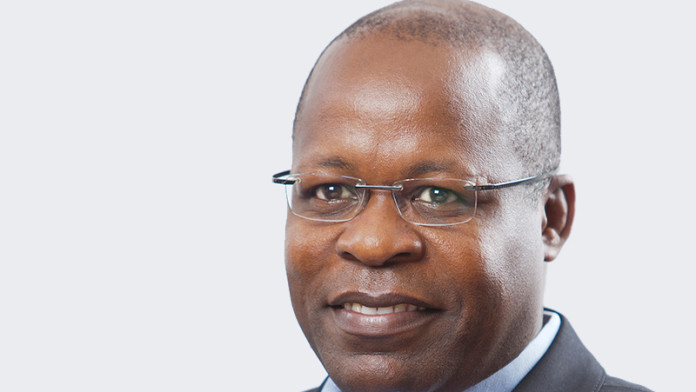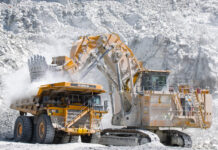
BEN Magara hasn’t had many opportunities to crack a smile during his two years as Lonmin CEO, but at a recent breakfast meeting he was in far brighter mood. The reason? Well, undoubtedly a good second-quarter performance had put a spring in his step.
Net cash was $11m higher and there had been an improvement in volumes notwithstanding a recent restructuring and community discontent at the E2 shaft in Rustenburg, the site of the Marikana Massacre with which Lonmin may forever be connected.
Perhaps the biggest contributing factor, however, was Magara’s redefined role – considered foolhardy by some – as both the company’s chief operating officer and CEO. As a mining engineer, Magara says he’s in his element. “You’re right. I love operating. I love people and I love my hands-on space.
“I’ve operated myself many times so it’s not like I’m learning how to get in there. And the two roles are sustainable in that Marikana is this 40km radius property: that’s where the energy is, that’s where our six general managers are, that’s where our processing facilities are, excepting Brakpan.
“I think we underestimate ourselves as leaders. When you get to a place and you give a sense of direction, and you’re doing it yourself, everyone wants to put their hands in there and push with you. I’m seeing those benefits of a direct hands-on approach with a flatter structure, a much more energised, self-empowered team.
“Everyone is wanting to be on board and everybody has the right energies. So it’s sustainable if I look at the operation and, if anything else, the most critical thing is that this is what Lonmin needs right now.”
One good quarter does not for a summer make though, and there are plenty of market critics who believe that Lonmin will be returning to shareholders for fresh funding less than two years after it raised about $400m in a controversial rights issue, eventually guaranteed by the South African government, which feared the loss of 30,000 jobs should Lonmin be forced to close its gates.
“Post Lonmin’s [first half] results, we continue to believe that it remains the global marginal cost producer of platinum,” said Goldman Sachs in a report in May. “As such, without the market for [platinum group metals] PGMs moving into deficit we expect that Lonmin will continue to burn cash.”
According to a report by Citi analysts, Johann Steyn and Shashi Shekhar, there’s a risk that Lonmin’s tangible net worth could fall below $1.1bn when it reports its full-year figures in November. Where that to happen, Lonmin’s debt covenants would be triggered and the company would be thrown into another liquidity crisis.
“We think this could result in Lonmin’s fourth rights issue in eight years,” they said. The miner has raised a total of $1.7bn in three separate rights issues since 2009 – each caused by balance sheet liquidity or solvency concerns.
Magara’s view is that is unlikely to materialise, partly owing to an agreement announced in November last year in which Anglo American Platinum (Amplats) will sell its 42.5% stake in the Pandora Joint Venture it shares with Lonmin to the miner for between R400m to R1bn. The variance in the consideration is owing to the transaction structure in which 20% of Pandora’s free cash flow will be distributed over six years whilst also allowing Amplats the use and full operational control of Lonmin’s Baobab concentrator for three years.
Having full control of Pandora enables Lonmin to mine areas of the adjacent Saffy shaft without incurring the same level of capital expenditure. “One of the benefits with the Pandora joint venture acquisition is that the capex synergies are about $2.6bn,” said Magara. “Those $2.6bn capex synergies definitely transfer to net present value as a saving. So on completion of this transaction there must be an uplift in the tangible net worth as well,” he said.
“Our aim since the rights issue has been to be at least cash neutral in this low-price environment and strong rand,” he said. “We are essentially there and thereabouts. We had $69m post the rights issue in 2015 and as we have just announced [on July 17] we had $86m.
“Where is the sustainability and what are the challenges right now? There’s still many headwinds, but I really believe that what Lonmin continues to prove is its resilience. It’s the people saying this company is in our hands; our jobs are in our hands and it’s from that sense of urgency that we have created this sustainable momentum.”
The topic of jobs is a sensitive one at Lonmin. The company cut about 6,860 jobs in its 2016 financial year taking down its full staff numbers to just over 33,000 souls. Then several months later it cut into its production target of about 700,000 ounces to about 650,000 to 680,000 oz for the 2017 financial year. Development crews were redeployed and contractors were reintroduced into the Generation One shafts, the older parts of the Marikana complex, in order to lift volume rates. Magara said the initiative worked.
“It was key to create the mining rhythm. After the challenges of December and the Christmas holidays it was very important to create that sense of urgency, to create that mining rhythm because without mining rhythm you really have a challenge to get the machine going. And that’s what we’ve got,” he said.
Lonmin was able to redeploy development staff – members of the mining team that open up new areas of the orebody in order to create flexibility – because it had some 22 months of mining already available – a fact that Magara said was Lonmin’s most competitive advantage. Now that there’s forward momentum in mining, the development crews have been returned to their areas. “So now most of our development crews have gone back to development to make sure that we continue to develop and do not compromise the 20 months of development that we still have left,” he said. Contractors had been put into the stoping areas vacated by development crew.
RMB Morgan Stanley analyst, Christopher Nicholson, said Magara’s efforts at Lonmin were tantamount to pulling one lever while triggering an equally undesirable consequence such as sacrificing mining development for higher mining of ore. Magara disagrees: “We continue to find these levers.”
One is the vamping or clean-up of old workings and smelter where the working capital has already been spent; another is some 29,000 oz to 30,000 oz a year that can be re-mined from tailings described by Magara as low capex and low cost. “There’s no nearer cash than that.
“The reality is that we are making Lonmin more sustainable, more resilient to withstand this current environment [of low PGM prices]. As long as the lower prices exist, we’re going to continue to have to find more levers for our sustainability.”









